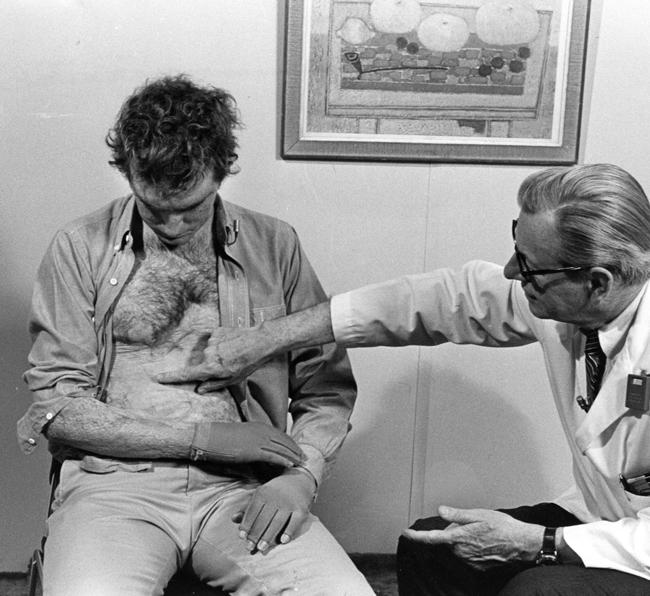Tinker, Tailor
An HMS surgeon looked to engineering to aid the severely burned
- 3 minute read
- Profile
Throughout the spring of 1980, ten severely burned patients were admitted to Massachusetts General Hospital. Their skin charred and stripped by third-degree burns, the patients risked shock, severe infection, and dehydration. John Burke ’51 and his team readied themselves for each surgery, which they believed would not only save the patient but might forever change the standard of care for severely burned patients.
Those expectations rested on findings that Burke, then chief of staff at the Shriners Burns Institute at Mass General and later the School’s Helen Andrus Benedict Professor of Surgery, and his collaborator Ioannis Yannas, an MIT professor of mechanical and biological engineering, had reported in a paper on the design of an artificial skin.

Prior to their research, treatment of severe burns required quick surgical removal of all badly burned skin, followed by covering the wound with skin grafts taken from an unscathed part of the patient’s body. Although this two-step procedure lowered infection rates and improved chances for survival, it also carried risks. Surgical placement of skin grafts is complex and requires adequate donor sites on the burn patient from which to harvest graft material. In large burns, this can mean repeated surgeries so that donor sites can heal and be re-harvested. Or, it can mean using grafts from other human donors, an option that requires the use of powerful immunosuppressant drugs to avoid graft rejection. Wanting to improve these patients’ outcomes, Burke and other scientists looked for new ways to replace the lost skin.
Burke had not planned to become a burn-treatment pioneer; he had been studying chemical engineering at the University of Illinois when World War II began. The war inspired him to reconsider his career, and in 1947, he enrolled at HMS with the goal of becoming a surgeon.
Medical school may have made Burke a surgeon, but he remained an engineer at heart. He recognized, for example, that replacing a component of the body with a material that would allow normal functioning required an engineering solution. In 1969, Burke joined Yannas on his search for a skin substitute. Their collaboration lasted 11 years and produced the first artificial skin used in surgery. The material they developed is now known as Integra.
To the eye, their invention looks like a thin, stretched-out jellyfish composed of two layers—one organic, the other synthetic. The first layer, designed to provide the base for a new dermis, is a scaffold of collagen and glycosaminoglycan, a substance found in shark cartilage. The second layer, made of silicone, is designed to protect the wound from infection and moisture loss. The collagen–glycosaminoglycan scaffold provides a surface into which cells can grow, a process that eventually causes the scaffold to break down and dissolve. The silicone material is removed after enough new skin has been generated.
The ten patients who entered Mass General that spring survived. The artificial skin developed by Burke and Yannas was declared a success; it had allowed the patients to grow a new dermis that was nearly scar-free.
“He had the ability to see the subtle changes in a disease process that made a big difference in medical practice,” says Peter Burke, chief of trauma services and professor of surgery at Boston University School of Medicine, and John Burke’s son. That ability led Burke to leave what may be his legacy to medicine—a product that bridges the gap between engineering and biology to provide an artificial skin for patients with third-degree burns.
Charli Kerns is a science-writer intern for Harvard Medicine magazine.
Image: Massachusetts General Hospital Archives